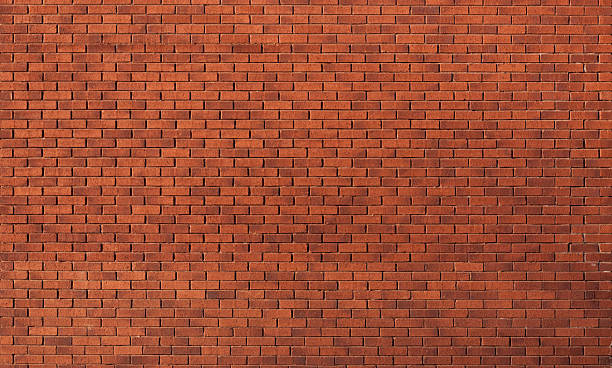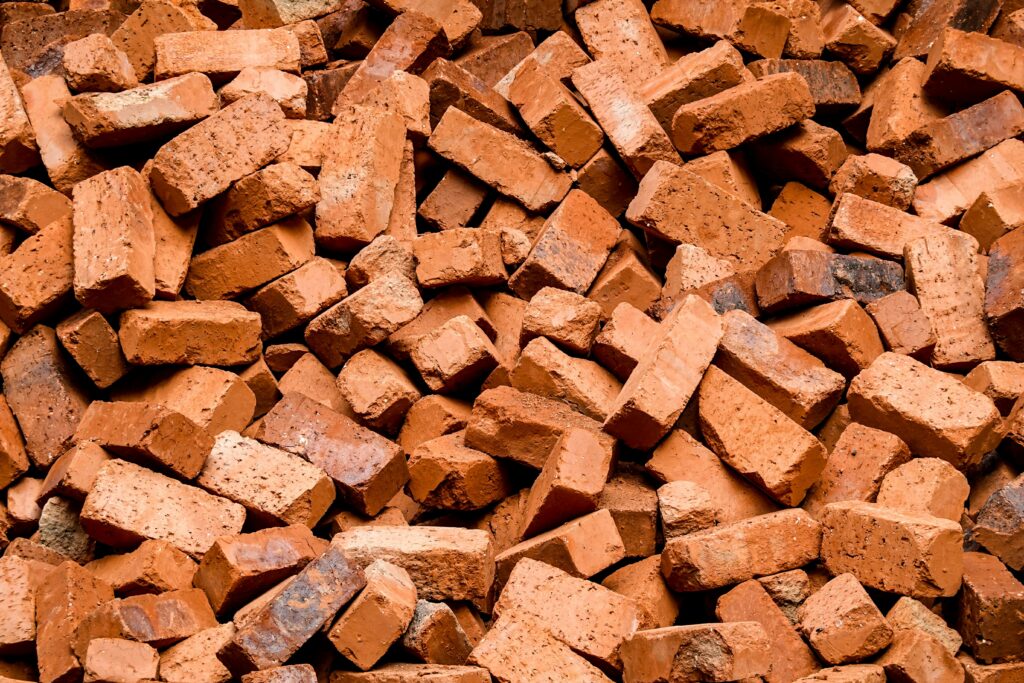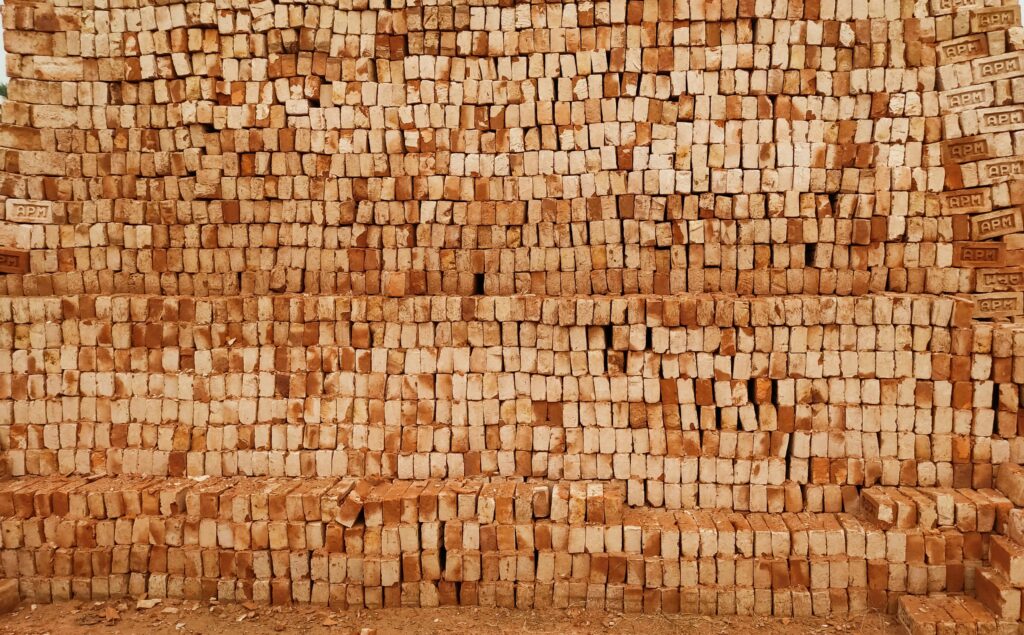WHY DO BRICKS PRICE MATTER ? – OVERVIEW
In the world of architecture, bricks are truly the base of every ambitious project—whether it’s a warm or cozy home, a busy or lively office, a vibrant or energetic school, or a lively shopping mall. However, with the increasing costs of raw materials and shifting demand, the bricks price in India and globally has experienced significant ups and downs throughout 2024 and into 2025.
For contractors, builders, architects, and even homeowners, staying updated on the current brick rates is important for effective budgeting and planning. This blog will take a closer look at the different types of bricks, their prices, and how to select the right one to meet our project needs.

POPULAR TYPES OF BRICKS USED IN INDIA – WITH PRICES IN 2025
India’s luxurious and versatile landscape, along with its different construction demands, has resulted in the use of different types of bricks. Here’s an in-depth list showing the average price for 1,000 bricks in INR:
| BRICKS | APPROX. PRICE PER (1000) | SIZE (MM) | APPROX. PRICE PER (1000) |
| Red clay bricks | ₹5,000-₹8,000 | 190x90x90 | Classic Construction |
| Fly ash bricks | ₹4,500-₹6,000 | 230x110x75 | Eco-friendly Buildings |
| AAC blocks | ₹3,000-₹5,000 (per m³) | depends | Modern Construction |
| Hollow bricks | ₹20-₹40 (per piece) | 400x200x200 | lightweight-construction |
| Concrete bricks | ₹7,500-₹9,000 | 400x200x100 | Load-Bearing Walls |
| Fire bricks | ₹30-₹60 (per piece) | 230x110x75 | Furnaces |
| Porotherm bricks | ₹30-₹80 (per piece) | 400x200x200 | Energy-Effective Homes |
| Sand lime bricks | ₹6000-₹8000 | 228x107x69 | Walls |
| Interlocking bricks | ₹30-₹50 (per piece) | depends | Modular Homes |
Prices can change depending on the city, supplier, and whether you’re buying in bulk. It’s always a good idea to check local rates before making a purchase.
GLOBAL RATES OF BRICKS
Now, let’s take a look at how bricks price assembled in global markets (these are approximate values converted to INR).
| COUNTRY | BRICK TYPE | PRICE PER 1000 BRICKS (INR) |
| USA | Red clay bricks | ₹40,000-₹70,000 |
| UAE | Concrete Hollow Bricks | ₹55,000-₹80,000 |
| UK | Facing Bricks | ₹30,000-₹50,000 |
| Australia | Clay & Sand Lime Bricks | ₹40,000-₹65000 |
| China | Fly Ash & Concrete Bricks | ₹20,000-₹50,000 |
These bricks price take into factors like quality, labour costs, energy expenses, and transportation involved in producing bricks worldwide.
STEP-BY-STEP OVERVIEW OF EACH BRICK TYPE (INCLUDES PROS, CONS AND PRICE TRENDS)
Looking to build or renovate? Here’s a quick summary of different types of bricks you might consider:
- Red Clay Bricks
Price: ₹5 – ₹8 each (₹5,000 – ₹8,000 for 1000)
Used for: Houses, boundary walls, rural construction
Pros: Durable and widely available
Cons: Absorb a lot of water; not the most eco-friendly option - Fly Ash Bricks
Price: ₹4.5 – ₹6 each (₹4,500 – ₹6,000 for 1000)
Used for: Eco-friendly constructions and green buildings
Pros: Lightweight, strong, and help reduce pollution
Cons: Require proper hardening and might not be the best choice in water-prone areas - AAC Blocks (Autoclaved Aerated Concrete)
Price: ₹3,000–₹5,000 per m³ (covers about 500–700 bricks)
Used for: High-rise buildings and commercial construction
Pros: Fireproof, soundproof, and thermally efficient
Cons: Higher cost and requires skilled labor - Hollow Bricks
Price: ₹20–₹40 each
Used for: Interior partitions and non-load-bearing walls
Pros: Lightweight, sound-insulating, and speeds up construction
Cons: Lower compressive strength - Concrete Bricks
Price: ₹7,500–₹9,000 for 1,000
Used for: Load-bearing walls and foundations
Pros: Strong and weather-resistant
Cons: Heavier than clay bricks - Fire Bricks (Refractory Bricks)
Price: ₹30–₹60 each
Used for: Kilns, ovens, and fireplaces
Pros: Can heat up to 1,800°C
Cons: Can be high in price - Porotherm Bricks
Price: ₹30–₹80 each
Used for: luxury homes, villas
Pros: Great thermal insulation, energy-efficient
Cons: Limited availability
8. Sand-Lime Bricks
Price: ₹6 – ₹8 each
Used for: Load-bearing walls, coated surfaces
Pros: Smooth finish, strong durability
Cons: Can be delicate, not suitable for every region
9. Interlocking Bricks
Price: ₹30 – ₹50 each
Used for: Quick-build homes, areas prone to earthquakes
Pros: No binding agent required, helps cut costs
Cons: Requires skilled installation, not ideal for high-rise buildings
FACTORS THAT DETERMINES BRICKS PRICE IN INDIA
Understanding what impacts brick prices can help you settle better deals:
Material Source: Clay, fly ash, or cement
Manufacturing Method: Kiln-burnt, machine-pressed, autoclaved
Size & Shape: Larger or custom bricks tend to be pricier
Transport Distance: Local bricks are generally cheaper than imported ones
Seasonal Demand: Prices tend to rise during the busy construction season (November to March)
Bulk Orders: Ordering in larger quantities can reduce the cost per unit
Labor Cost & Automation: While machine-made bricks offer consistency, they might come with a higher initial price tag

HOW TO CHOOSE THE CORRECT BRICK FOR YOUR CONSTRUCTION?
| REQUIREMENT | RECOMMENDED BRICK | WHY THIS? |
| In Budget Construction | Fly Ash & Red Bricks | Affordable & Available |
| Eco-Friendly Building | AAC Blocks & Fly Ash | Less Carbon Footprint |
| Load-Bearing Walls | Concrete, Sand Lime | High Strength |
| Multi-Storey Building | Concrete, Porotherm | Lightweight & Strong |
| Fast Construction | Interlocking , Hollow Bricks | Less Hardening Time |
| Fire Resistance | Fire Bricks | Bear High Temperature |
BRICKS PRICE PER 1000 IN TOP INDIAN CITIES
| CITY | RED BRICK PRICE PER (1000) | FLY ASH BRICKS PER (1000) | AAC BLOCKS PER (m³) |
| Delhi NCR | ₹8,000- ₹9000 | ₹5,000-₹6000 | ₹3,800-₹5,000 |
| Mumbai | ₹6500- ₹8000 | ₹5,000-₹7,000 | ₹3,500-₹4,800 |
| Bengaluru | ₹6,000- ₹7,000 | ₹5,000-₹6,000 | ₹3,000-₹4,500 |
| Hyderabad | ₹6,000-₹7,000 | ₹4,800-₹6,500 | ₹3,000-₹4,700 |
| Chennai | ₹7,000-₹9000 | ₹5,500-₹6,500 | ₹3,500-₹5,000 |
Brick Price Calculation METHOD
If you’re looking to figure out how many bricks you need and what cost, here’s a simple formula:
Number of Bricks = (Wall Area in sq.m × 500) / 1000
Total Cost = Number of Bricks × Price per Brick
TIPS FOR SCORING THE BEST BRICK PRICE
- Compare prices from at least three local suppliers
- Buy in bulk to get some discounts
- Look for BIS certification (IS 1077:1992)
- Request samples before placing a large order
- Guide clear of deliveries during the monsoon season

BRICKS TREND PRICE IN 2022-2025
- 2022–2023: Prices rose due to coal and fuel shortages
- 2024: Prices stabilized thanks to government subsidy schemes
- 2025: A slight increase is expected due to rising labor costs and raw material inflation
CONCLUSION
Smart Buying = Smart Building
Choosing the right type of brick and being aware of brick prices in India can help you save money while ensuring your project is durable, energy-efficient, and sustainable. Whether you’re constructing a cozy home or a commercial space, take the time to compare your options, understand quality, and choose based on your specific needs.
For 2025, AAC blocks and fly ash bricks are trending for their eco-friendliness and performance, but red clay bricks still hold strong in rural and budget-friendly projects.
FAQs-FREQUENT ASKED QUESTIONS
1. What is the current price of 1000 bricks in India in 2025?
In 2025, the average cost for 1000 red clay bricks in India falls between ₹5,000 and ₹8,000. The bricks price can differ based on the type of brick, location, and supplier.
2. Which type of brick is cheapest in India?
Fly ash bricks are among the most affordable options, priced at about ₹4.5 to ₹6 each, making them a great choice for those on a budget and environmentally conscious.
3. What is the price of AAC blocks in India?
In 2025, AAC blocks typically cost between ₹3,000 and ₹5,000 per cubic meter. To give you an idea, one cubic meter is roughly equial to 500–700 standard bricks.
4. Why are brick prices increasing in 2025?
The rise in brick prices can be because of several factors, including fuel costs, labor shortages, heightened demand, and adjustments in GST and transportation expenses.
5. Which bricks are best for house construction in India?
For modern homes, AAC blocks, fly ash bricks, and porotherm bricks are top choices due to their thermal insulation and durability. Red clay bricks remain a favorite for traditional structures.
6. What is the size of standard bricks in India?
The standard dimensions for a brick in India are 190 mm x 90 mm x 90 mm, not including binding agents.
7. Can I negotiate brick prices while buying in bulk?
Absolutely! Most suppliers are open to offering discounts for bulk orders (5000+ bricks). It’s always a good idea to shop around and compare prices from local dealers to find the best wholesale rates.
8. Which bricks are most eco-friendly?
Fly ash bricks, AAC blocks, and porotherm bricks are recognized as eco-friendly options since they help minimize environmental pollution and are made from recycled materials.
9. How many bricks are required to build a 1000 sq. ft. house?
Roughly 35,000 to 40,000 bricks are needed, depending on the design, wall thickness, and brick type.
“What Is Clay Brick Made Of? 5 Powerful Benefits and 3 Major Issues”
Benefits of Eco-Friendly Bricks: A Smart Choice for a “Greener Future” Guide—2025
Read more of my blog to understand more about bricks.